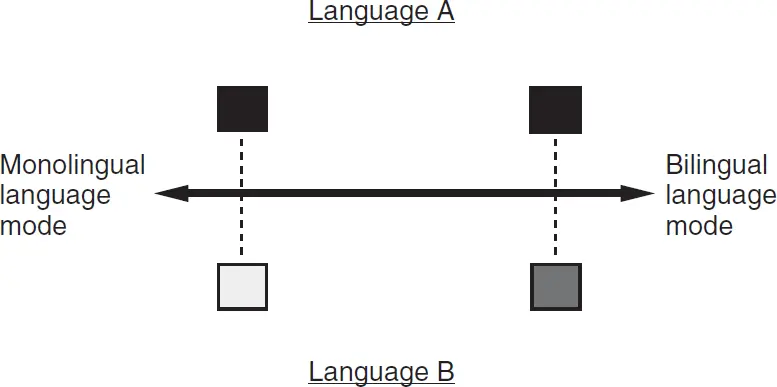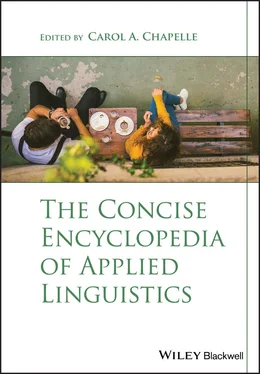19 Lambert, W. E. (1977). The effects of bilingualism on the individual: Cognitive and sociocultural consequences. In P. A. Hornby (Ed.), Bilingualism: Psychological, social, and educational implications (pp. 15–27). New York, NY: Academic Press.
20 Laufer, B. (2003). The influence of L2 on L1 collocational knowledge and on L1 lexical diversity in free written expression. In V. Cook (Ed.), Effects of the second language on the first (pp. 19–31). Clevedon, England: Multilingual Matters.
21 Majid, A., Jordan, F., & Dunn, M. (2015). Semantic systems in closely related languages. Language Sciences, 49, 1–18.
22 Marian, V., & Spivey, M. (2003). Competing activation in bilingual language processing: Within and between‐language competition. Bilingualism: Language and Cognition, 6, 97–115.
23 Morford, J. P., Kroll, J. F., Piñar, P., & Wilkinson, E. (2014). Bilingual word recognition in deaf and hearing signers: Effects of proficiency and language dominance on cross‐language activation. Second Language Research, 30, 251–71.
24 Nicolay, A.‐C., & Poncelet, M. (2015). Cognitive benefits in children enrolled in an early bilingual immersion school: A follow‐up study. Bilingualism: Language and Cognition, 18, 789–95.
25 Paap, K. R., & Greenberg, Z. I. (2013). There is no coherent evidence for a bilingual advantage in executive processing. Cognitive Psychology, 66, 232–58.
26 Pavlenko, A. (2000). L2 influence on L1 in late bilingualism. Issues in Applied Linguistics, 11, 175–205.
27 Pavlenko, A. (2005). Bilingualism and thought. In J. F. Kroll & A. M. B. de Groot (Eds.), Handbook of bilingualism: Psycholinguistic approaches (pp. 433–53). New York, NY: Oxford University Press.
28 Peal, E., & Lambert, W. E. (1962). The relation of bilingualism to intelligence. Psychological Monographs, 76, 1–23.
29 Rah, A., & Adone, D. (2010). Processing of the reduced relative clause versus main verb ambiguity in L2 learners at different proficiency levels. Studies in Second Language Acquisition, 32, 79–109.
30 Saer, D. J. (1923). The effects of bilingualism on intelligence. British Journal of Psychology, 14, 25–38.
31 Smith, F. (1923). Bilingualism and mental development. British Journal of Psychology, 13, 270–82.
32 Starreveld, P. A., De Groot, A. M. B., Rossmark, B. M. M., & Van Hell, J. G. (2014). Parallel language activation during word processing in bilinguals: Evidence from word production in sentence context. Bilingualism: Language and Cognition, 17, 258–76.
33 Sundara, M., Polka, L., & Molnar, M. (2008). Development of coronal stop perception: Bilingual infants keep pace with their monolingual peers. Cognition, 108, 232–42.
34 Valian, V. (2015). Bilingualism and cognition. Bilingualism: Language and Cognition, 18, 3–24.
35 Wen, Y., Filik, R., & Van Heuven, W. J. B. (2018). Electrophysiological dynamics of Chinese phonology during visual word recognition in Chinese‐English bilinguals. Scientific Reports, 8. doi: 10.1038/s41598‐018‐25072‐w
1 Cook, V. (Ed.). (2003). Effects of the second language on the first. Clevedon, England: Multilingual Matters.
2 De Groot, A. M. B. (2011). Language and cognition in bilinguals and multilinguals: An introduction. New York, NY: Psychology Press.
3 Filipović, L., & Pütz, M. (Eds.). (2014). Multilingual cognition and language use: Processing and typological perspectives. Amsterdam, Netherlands: John Benjamins.
4 Gentner, D., & Goldin‐Meadow, S. (Eds.). (2003). Language in mind: Advances in the study of language and cognition. Cambridge, MA: MIT Press.
5 Schwieter, J. W. (Ed.). (2015). The Cambridge handbook of bilingual processing. Cambridge, England: Cambridge University Press.
Bilingual and Monolingual Language Modes
FRANÇOIS GROSJEAN
Bilinguals communicate differently when they are with monolinguals and when they are with bilinguals who share their languages. Whereas they avoid using their other language(s) with monolinguals, they may call upon it (or them) when interacting with bilinguals, either by changing over completely to the other language(s) or by bringing elements of the other language(s) into the language they are speaking.
This change of behavior, which affects both language production and language perception, has been alluded to by well established researchers over the years. Thus, Weinreich 1966, one of the founding fathers of bilingualism research, wrote in his classic book, Languages in Contact , that bilinguals limit interferences when speaking to monolinguals (he used “interference” as a cover term for any element of the other language), whereas, when speaking to other bilinguals, they use them freely. Other researchers such as Hasselmo 1970 and Baetens Beardsmore 1986 have made similar points. Grosjean has investigated this phenomenon—language mode—in a series of publications (Grosjean, 1985 1989, 1994; see Grosjean, 2001 2008, for reviews).

Figure 1 A visual representation of the language‐mode continuum Note. Two positions on the continuum are illustrated for a person with two languages (A and B): toward the monolingual end (on the left) and toward the bilingual end (on the right). The level of activation of a language (square) is depicted by the degree of darkness (black represents an active language and white an inactive or deactivated one).
Language Mode
Description
Language mode is the state of activation of the bilingual's languages and language‐processing mechanisms at a given point in time. Figure 1illustrates the concept which is best presented as a continuum in a two‐dimensional representation. The bilingual's two languages (A and B) are depicted on the vertical axis by squares.
Two positions on the continuum are illustrated in the figure. In both positions, language A is the most active (it is the main language being used, or base language, hence the black square) and language B is active to varying degrees. On the left, language B is only very slightly active (lighter square), and the bilingual is said to be at, or close to, a monolingual language mode. On the right, language B is active (darker square), but it is not as active as language A, and the bilingual is said to be in a bilingual mode. (To simplify matters, we will mention only two languages at this point, but language mode applies also to three or more languages, as we will see below.)
Bilinguals will usually be in a monolingual mode (left part of the figure) when they are interacting with monolinguals with whom they simply cannot use their other language (here, language B). They have to deactivate the latter, usually unconsciously, so that it is not produced and hence lead to a breakdown in communication. They can also be in a monolingual mode with other bilinguals if they have only one language in common. Bilinguals will be in a bilingual mode (right part of the figure) when interacting with other bilinguals who share their languages and with whom they feel comfortable bringing in the other language. In this case, both languages are active, but one language (language B here) is slightly less active as it is not the main language of communication. Bilinguals can also be in an intermediate mode (between the two end points), for instance when they know that their interlocutor is bilingual but does not like to mix languages. In this case, the other language (language B in the example) will be only partly activated. What has just been said about speakers applies to listeners; they can find themselves at various points along the continuum depending on what they are hearing as well as on situational factors such as knowing that they share the same two languages with their interlocutor.
Читать дальше













